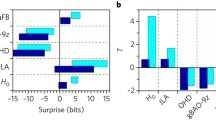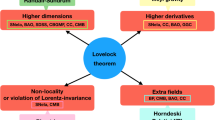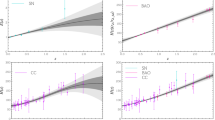Abstract
We explore and compare the capabilities of the recent observations of standard cosmological probes and the future observations of gravitational-wave (GW) standard sirens on constraining cosmological parameters. It is carried out in the frameworks of two typical dynamical models of cosmology, i.e., the \(\omega _0\omega _a\)CDM model with \(\omega (z) = \omega _0 +\omega _a*z/(1+z)\), and the \(\xi \)-index model with \(\rho _X\propto \rho _ma^{\xi }\), where \(\omega (z)\) is the dark energy equation of state, and \(\rho _X\) and \(\rho _m\) are the energy densities of dark energy and matter, respectively. In the cosmological analysis, the employed data sets include the recent observations of the standard cosmological probes, i.e., Type Ia supernovae (SNe Ia), baryon acoustic oscillation (BAO) and cosmic microwave background (CMB), and also the mock GW standard siren sample with 1000 merging neutron star events anticipated from the third-generation detectors. In the scenarios of both \(\omega _0\omega _a\)CDM and \(\xi \)-index models, it turns out that the mock GW sample can reduce the uncertainty of the Hubble constant \(H_0\) by about 50% relative to that from the joint SNe+BAO+CMB sample; nevertheless, the SNe+BAO+CMB sample demonstrates better performance on limiting other parameters. Furthermore, the Bayesian evidence is applied to compare the dynamical models with the \(\Lambda \)CDM model. The Bayesian evidences computed from the SNe+BAO+CMB sample reveal that the \(\Lambda \)CDM model is the most supported one; moreover, the \(\omega _0\omega _a\)CDM model is more competitive than the \(\xi \)-index model.



Similar content being viewed by others
Data Availability Statement
This manuscript has associated data in a data repository. [Authors’ comment: The data underlying this paperwill be shared on reasonable request to the corresponding author.]
Notes
While the space detector LISA is good at detecting events of coalescing supermassive black hole binaries at large redshift.
References
D. Huterer, D.L. Shafer, Dark energy two decades after: observables, probes, consistency tests. Rep. Prog. Phys. 81, 016901 (2018)
P.J. Peebles, B. Ratra, The cosmological constant and dark energy. Rev. Mod. Phys. 75, 559 (2003)
P. Bull et al., Beyond \(\Lambda \)CDM: problems, solutions, and the road ahead. Phys. Dark Univ. 12, 56 (2016)
J.S. Bullock, M. Boylan-Kolchin, Small-Scale Challenges to the \(\Lambda \)CDM Paradigm. ARAA 55, 343 (2017)
S. Weinberg, The cosmological constant problem. Rev. Mod. Phys. 61, 1 (1989)
S.M. Carroll, W.H. Press, E.L. Turner, The cosmological constant. ARAA 30, 499 (1992)
S. Weinberg, The cosmological constant problems, arXiv:astro-ph/0005265
A. Vilenkin, Cosmological constant problems and their solutions, arXiv:hep-th/0106083
J. Garriga, M. Livio, A. Vilenkin, The cosmological constant and the time of its dominance. Phys. Rev. D 61, 023503 (1999)
J. Garriga, A. Vilenkin, Solutions to the cosmological constant problems. Phys. Rev. D 64, 023517 (2001)
E.J. Copeland, M. Sami, S. Tsujikawa, Dynamics of dark energy. Int. J. Mod. Phys. D 15, 1753 (2006)
L. Amendola, Coupled quintessence, arXiv:astro-ph/9908023v1
G. Caldera-Cabral, R. maartens, A.Urena-Lopez, Dynamics of interacting dark energy, arXiv:08121827v2
M. Chevallier, D. Polarski, Accelerating universes with scaling dark matter. Int. J. Mod. Phys. D 10, 213 (2001)
E.V. Linder, Exploring the expansion history of the universe. Phys. Rev. Lett. 90, 091301 (2003)
N. Dalal et al., Testing the cosmic coincidence problem and the nature of dark energy. Phys. Rev. Lett. 87, 141302 (2001)
D. Scolnic, et al., The complete light-curve sample of spectroscopically confiAstrophys. J.rmed SNe Ia from Pan-STARRS1 and cosmological constraints from the combined pantheon sample. Astrophys. J. 859 101 (2018)
F. Beutler et al., The 6dF Galaxy Survey: baryon acoustic oscillations and the local Hubble constant. Mon. Not. R. Astron. Soc. 416, 3017 (2011)
A.J. Ross et al., The clustering of the SDSS DR7 main Galaxy sample - I. A 4 per cent distance measure at z = 0.15. Mon. Not. R. Astron. Soc. 449 835 (2015)
S. Alam et al., The clustering of galaxies in the completed SDSS-III Baryon Oscillation Spectroscopic Survey: cosmological analysis of the DR12 galaxy sample. Mon. Not. R. Astron. Soc. 470, 2617 (2017)
N. Aghanim et al., Planck 2018 results. VI. Cosmol. Parameter. 641, A6 (2020)
B. Schutz, Determining the Hubble constant from gravitational wave observations. Nature 323, 310–311 (1986)
B.P. Abbott et al., Nature 551, 85–88 (2017)
R.-G. Cai, T. Yang, Estimating cosmological parameters by the simulated data of gravitational waves from the Einstein Telescope. Phys. Rev. D 95, 4 (2017)
X.-N.Zhang, et al., Improving cosmological parameter estimation with the future gravitational-wave standard siren observation from the Einstein Telescope, Phys. Rev. D 99 063510 (2019)
J.-F. Zhang et al., Cosmological parameter estimation with future gravitational wave standard siren observation from the Einstein Telescope. JCAP 09, 068 (2019)
M.-H. Du, L.-X. Xu, How will our knowledge of short gamma-ray bursts affect the distance measurement of binary neutron stars? Sci. China-Phys. Mech. Astron. 65, 219811 (2022)
X.-L. Li, et al., Testing and selecting cosmological models with ultra-compact radio quasars, arXiv:1708.08867
B. Liu et al., Complementary constraints on dark energy equation of state from strongly lensed gravitational wave. MNRAS 487, 1980–1985 (2019)
Z.-W. Zhao et al., Cosmological parameter estimation for dynamical dark energy models with future fast radio burst observations. ApJ 903, 83 (2020)
J.-Z. Qi, et al., Using a multi-messenger and multi-wavelength observational strategy to probe the nature of dark energy through direct measurements of cosmic expansion history, arXiv:2102.01292
D. Pavón, S. Sen, W. Zimdahl, CMB constraints on interacting cosmological models. JCAP 5, 009 (2004)
Z.K. Guo, N. Ohta, S. Tsujikawa, Probing the coupling between dark components of the universe. Phys. Rev. D 76, 023508 (2007)
Y. Chen et al., Using a phenomenological model to test the coincidence problem of dark energy. Astrophys. J. 711, 439 (2010)
S. Cao, N. Liang, Z.-H. Zhu, Testing the phenomenological interacting dark energy with observational H(z) data. Mon. Not. R. Astron. Soc. 416, 1099 (2011)
M.-J. Zhang, W.-B. Liu, Observational constraint on the interacting dark energy models including the Sandage-Loeb test. EPJC 74, 2863 (2014)
D. Branch, D.L. Miller, Type IA supernovae as standard candles. APJL 405, L5 (1993)
A.G. Riess, W.H. Press, R.P. Kirshner, Using Type IA supernova light curve shapes to measure the Hubble constant. APJL 438, L17 (1995)
A.V. Filippenko, Type Ia supernovae and cosmology. ASSL 332, 97 (2005)
J. Guy et al., SALT: a spectral adaptive light curve template for type Ia supernovae. Astron. Astrophys. 443, 781 (2005)
J. Guy et al., SALT2: using distant supernovae to improve the use of type Ia supernovae as distance indicators. Astron. Astrophys. 466, 11 (2007)
A. Conley et al., SiFTO: an empirical method for fitting SNe Ia light curves. Astrophys. J. 681, 482 (2008)
M. Betoule et al., Improved cosmological constraints from a joint analysis of the SDSS-II and SNLS supernova samples. Astron. Astrophys. 568, A22 (2014)
R. Kessler, D. Scolnic, Correcting Type Ia supernova distances for selection biases and contamination in photometrically identified samples. Astrophys. J. 836, 56 (2017)
R. Giostri et al., From cosmic deceleration to acceleration: new constraints from SN Ia and BAO/CMB. JCAP 03, 027 (2012)
D.J. Eisenstein, W. Hu, Astrophys. J. 496, 605 (1998)
D.J. Eisenstein et al., Detection of the baryon acoustic peak in the large-scale correlation function of SDSS luminous red galaxies. Astrophys. J. 633, 560 (2005)
J. Ryan, Y. Chen, B. Ratra, Baryon acoustic oscillation, Hubble parameter, and angular size measurement constraints on the Hubble constant, dark energy dynamics, and spatial curvature. Mon. Not. R. Astron. Soc. 488, 3844 (2019)
G. Hinshaw et al., Nine-year Wilkinson microwave anisotropy probe (WMAP) observations: cosmological parameter results. Astrophys. J. Suppl. 208, 19 (2013)
Y. Akrami, et al., Planck 2018 results. IV. Diffuse component separation, Astron. Astrophys. 641 74 (2020)
N. Aghanim, et al., Planck 2018 results. V. CMB power spectra and likelihoods, Astron. Astrophys. 641 92 (2020)
E. Belgacem et al., Cosmology and dark energy from joint gravitational wave-GRB observations. JCAP 08, 015 (2019)
T.G.F. Li, Extracting physics from gravitational waves, Spring Theses (2015)
J.-F. Zhang, H.-Y. Dong, J.-Z. Qi, X. Zhang, Extracting physics from gravitational waves. EPJC 80, 217 (2020)
X.N. Zhang, L.F. Wang, J.F. Zhang, X. Zhang, Phys. Rev. D 99, 063510 (2019)
M. Du, W. Yang, L. Xu, S. Pan, D.F. Mota, Phys. Rev. D 100, 043535 (2019)
R.G. Cai, T. Yang, Phys. Rev. D 95, 044024 (2017)
W. Zhao, C. Van Den Broeck, D. Baskaran, T.G.F. Li, Phys. Rev. D 83, 023005 (2011)
S. Nissanke et al., Exploring short gamma-ray bursts as gravitational-wave standard sirens. ApJ 725, 496–514 (2010)
X.-L. Fan, C. Messenger, I.S. Heng, Probing intrinsic properties of short gamma-ray bursts with gravitational waves. Phys. Rev. Lett. 119, 181102 (2017)
A. Lewis, S. Bridle, Cosmological parameters from CMB and other data: a Monte Carlo approach. Phys. Rev. D 66, 103511 (2002)
R. Trotta, Bayes in the sky: Bayesian inference and model selection in cosmology. Contemp. Phys. 49, 71 (2008)
G. Efstathiou, Limitations of Bayesian evidence applied to cosmology. Mon. Not. R. Astron. Soc. 388, 1314 (2008)
M. Szydlowski et al., AIC, BIC, Bayesian evidence against the interacting dark energy model. Eur. Phys. J. C 75, 5 (2015)
A. Heavens, et al., Marginal Likelihoods from Monte Carlo Markov Chains, arXiv:1704.03472
Acknowledgements
We would like to thank Minghui Du for supplying the mock catalog of BNS-SGRB GW events and also for some helpful suggestions on the use of the mock sample. This work has been supported by the National Natural Science Foundation of China (Nos. 11988101, 12021003, 12033008, 11633001, 11920101003, 11703034, 11773032 and 11573031), the Strategic Priority Research Program of the Chinese Academy of Sciences (No. XDB23000000), the Interdiscipline Research Funds of Beijing Normal University, and the K. C. Wong Education Foundation.
Author information
Authors and Affiliations
Corresponding authors
Rights and permissions
About this article
Cite this article
Zheng, J., Chen, Y., Xu, T. et al. Investigating the dynamical models of cosmology with recent observations and upcoming gravitational-wave data. Eur. Phys. J. Plus 137, 509 (2022). https://doi.org/10.1140/epjp/s13360-022-02718-3
Received:
Accepted:
Published:
DOI: https://doi.org/10.1140/epjp/s13360-022-02718-3




